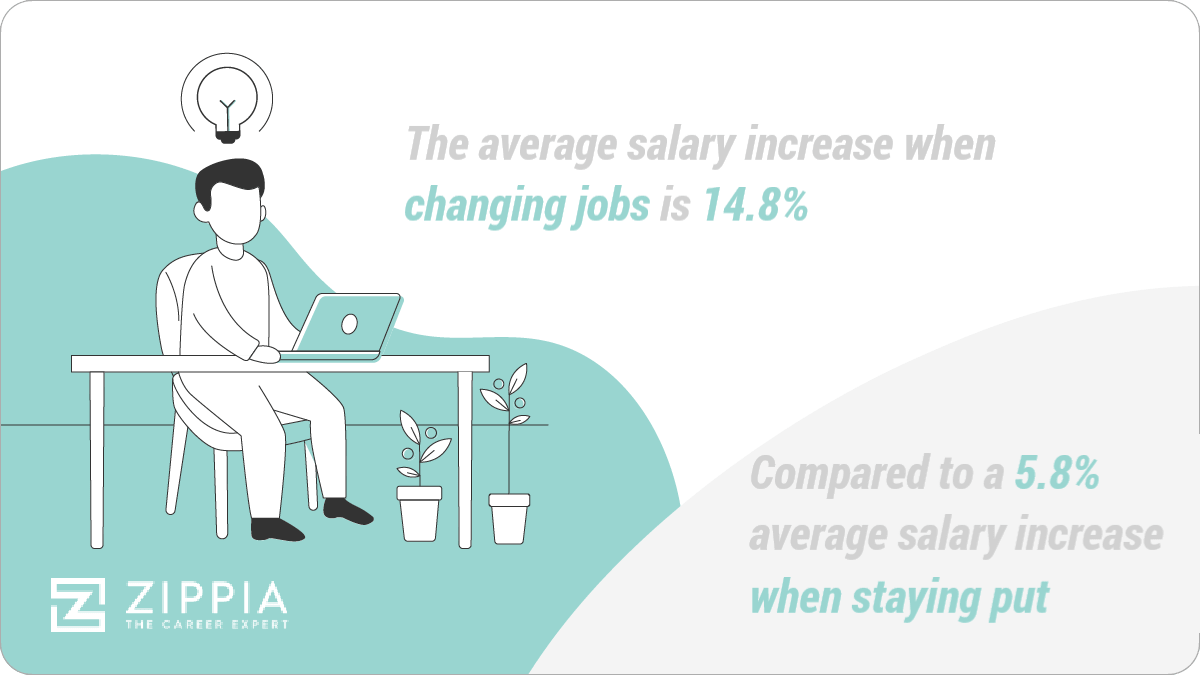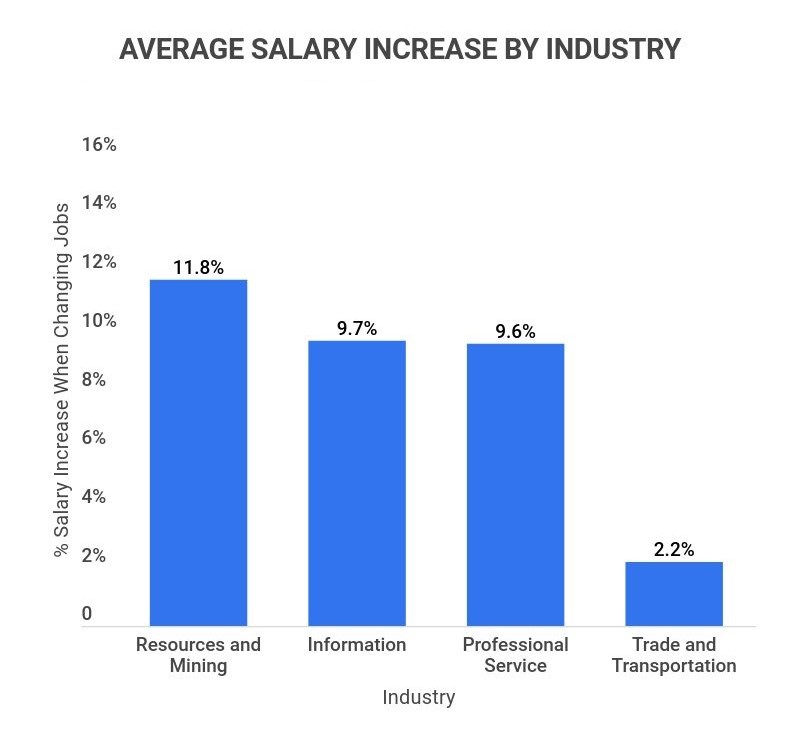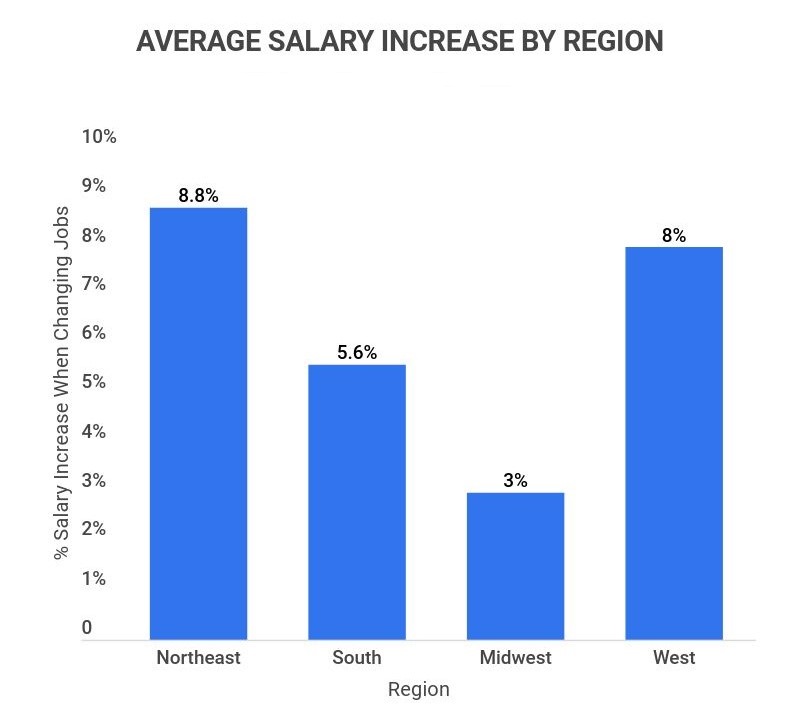- Job Seeker Statistics
- Career Change statistics
- Internship Statistics
- Job Search Statistics
- Average Number Of Jobs Applied
- Average Salary Increase When Changing Jobs
- Part Time Job Statistics
- Age Discrimination Statistics
- Networking Statistics
- Interview Statistics
- Average Number of Jobs In A Lifetime
- Resume Statistics
- Side Hustle Statistics
- Teacher Statistics
Research Summary. Changing jobs can be an uncertain endeavor. Maybe you feel stuck in your current position because you doubt your ability to land a new job. However, the truth is that most people receive a salary increase when switching jobs. And those who stay in the same place for over two years actually tend to make less.
So, what is the average raise in 2023? After extensive research, our data analysis team concluded what the average percentage salary increase for new job is:
-
The average salary increase when changing jobs is 14.8%, while wage growth is 5.8%.
-
The Resources and Mining industry has the highest wage increase for changing jobs at 11.8%.
-
Leisure and Hospitality is the only industry with a negative average wage growth when changing jobs, at -1.3%.
-
Those between the ages of 25-34 receive the highest average wage increase when changing jobs at 9.8%.
-
Bigger companies offer big raises; companies with 1000+ employees offer an average pay raise of 6.9%.
-
Those living in the Northeast can expect the highest pay raises when switching jobs, at an average of 8%.
-
Women receive 0.09% more wage growth than men when changing jobs, on average.
For further analysis, we broke down the data in the following ways:
Industry | Demographics | Region

Average Salary Increase for Job-Switchers by Industry
| Industry | Average Salary Increase |
|---|---|
| Resources and Mining | 11.8% |
| Information | 9.7% |
| Professional Service | 9.6% |
| Trade and Transportation | 2.2% |
| Leisure and Hospitality | -1.3% |
General Average Salary When Changing Jobs Statistics
Because you’re likely to gain when switching jobs, it’s worth noting how these gains can vary. For instance, most people want a 10-20% salary increase, but not everyone achieves that. Here are the facts:
-
The average salary increase is 14.8%, but the average wage growth is only 5.8%.
While many people achieve their increased salary expectations of 10-20%, their overall wage growth can be much lower. Two of the larger causes for skewing these results are company size and age, as companies with less than 50 employees see wage growth of only 4.6%, while those 55 or older also only see 4.1% wage growth.
-
Wage growth for job switchers is 47% higher than those who stay in their current job.
Wage growth for those who switch jobs is 5.8%, while that number for those who stay in their current job is only 3.1%. While this might not seem like a lot on paper, those who stay in their current jobs are essentially seeing half of the wage growth.
-
Wage growth for job switchers has risen by 0.68% since 2020.
While on the other hand, wage growth for those who’ve stayed in their current position has actually shrunk by 1.01%.
-
Overall employment growth has been up by 11.6% since 2020.
As of 2021, total employment growth is at 3.5%, a considerable increase from 2021.
-
The average wage level for job switchers is $30.37.
Which is double that of job entrants but $3.66 less than current jobholders. Of course, these are averages and can vary significantly depending on the industry or job type.
Average Salary When Changing Jobs by Industry
Your chances of landing a higher salary can also vary depending on your industry. While you can expect an increased salary most of the time, there are some industries where this isn’t the case. Plus, not every salary increase is equal. Here are some other insights our research uncovered:
-
The Resources and Mining industry offers an 11.8% average wage increase when switching jobs.
That’s up 5.3% from last year and an extra 18% more on average than the next closest industry. Altogether, that makes this industry a great option for changing jobs.
-
The Leisure and Hospitality industry is the only industry with negative wage growth of -1.3%.
And that number hasn’t changed much since last year. Overall, this industry is far behind all of the others.
-
The Information and Professional Service industries have the second-highest wage growth when switching, with 9.7% and 9.6% respectively.
That’s still 40% higher than the overall average of 5.8%, making it easy and profitable to change jobs in these industries.
-
The Trade and Transportation industry has the lowest positive wage growth for switching jobs at 2.2%.
And is continuing to trend downwards, as it decreased by 1.3% within the last year.

Average Salary When Changing Jobs Demographics
Age and gender also have an impact on the salaries and wage growth of those who change jobs. Generally speaking, the highest salary increases cap out at around 35 and then decrease from there. According to our research:
-
Those 55+ years old see the smallest wage increases, at only 4.1%
By contrast, those between 25 and 34 can expect an average wage increase of 9.8%, 58% higher than the older demographic.
-
Workers between the ages of 16-24 have seen a 1.7% decrease in wage growth since 2020.
While this age range’s wage growth of 6% when switching jobs is still higher than the 55+ age range, it’s seen the most significant decrease within the past year.
-
On average, women receive 14% higher wage growth when changing jobs.
When changing jobs for men, the average wage growth is 5.5%, and the average for women is 6.4%. Women have also seen a more steady increase in their wage growth when changing jobs, with a 1.1% uptick from 2020-2021.
On the other hand, men only saw a 0.2% increase. However, women still make less than men on average, at a rate of $32.61 to $27.79.
-
While race doesn’t seem to impact salary negotiations, college-educated black men still make 20% less than college-educated white men.
That’s the difference between the white individual making $30 per hour while the black individual only makes $24.
-
Companies with 500-1,000 employees offer the worst salaries for those changing jobs at 3.2%.
Even worse than the 4.6% wage growth afforded to those changing jobs with companies who have less than 50 employees, companies with 500-1,000 employees only have a 3.2% average wage growth. That’s 45% less than the national average.
-
Companies with 1,000+ employees have the highest wage growth for those changing jobs at 6.9%.
That’s 16% higher than the national average and continues to increase at a rate greater than other firm sizes. From 2020-2021, the job-change wage growth for these companies increased by 1.7%.

Average Salary When Changing Jobs by Region
Where you are on the map can also impact your average salary when changing jobs. How does your location affect your typical salary when changing jobs? Here’s what we found:
-
The Northeast (New England) offers the highest average wage growth when changing jobs, at an 8.8% increase.
And this number has also increased the most compared to other regions as well, at a rate of 2.1% from 2020 to 2021. The Northeast’s wage growth is also 11% higher than the West.
-
Employees in the West get an average raise of 8% when changing jobs.
-
The Midwest is the worst for changing jobs, with an average wage growth rate of only 3%.
And this number is currently decreasing, as it went down by 1.9% over the course of 2020.
-
The South has the lowest average salary for those who change jobs, at $27.01.
Compared to the North and West, who offer an average job-change salary of $35.32 and $34.76 respectively. However, when changing jobs in the South, wage growth is still higher than in the Midwest, at 5.6%.
This includes states like California, Oregon, and Washington.

Average Salary Increase for Job-Switchers by Region
| Region | Average Salary Increase When Changing Jobs |
|---|---|
| Northeast | 8.8% |
| West | 8% |
| South | 5.6% |
| Midwest | 3% |
Average Salary Increase When Changing Jobs FAQ
-
What is the average salary increase when changing jobs?
As of 2021, the average salary increase when changing jobs is 5.8%. That’s up from 0.68% from 2020. Depending on your industry, wage growth when switching jobs can be as low as -1.3% (Leisure and Hospitality) or as high as 11.8% (Resources and Mining).
Age also plays a significant role, with workers aged 25-34 receiving a 9.8% average salary increase when changing jobs, compared to 55+-year-olds receiving a 4.1% average raise for switching.
-
What is a good salary increase when changing jobs?
Generally speaking, a good and reasonable salary increase when changing jobs is between 10-20%. The national average is around 14.8%, so don’t be afraid to ask for a similar increase. At a minimum, you should expect a wage growth of at least 5.8% when you change positions.
-
How much of a salary increase should you ask for when changing jobs?
You should ask for a 10-20% salary increase when changing jobs. It’s likely that you’ll end up negotiating for less than you initially ask for, but starting with a higher figure allows more room for this.
Your current salary, your industry, and the general state of the economy, both local and national, should also play into your expectations. Do your research on what a professional with your skill set, education, and level of experience should expect to earn using online salary calculators.
Don’t focus too much on getting a specific percentage to raise — just make sure you’re being paid fairly for the work you’re doing.
-
Should I apply to positions in regions with higher wage growth?
Yes and no, sometimes applying to positions in regions with higher wage growth can be a good decision. While higher wage growth is nice on paper and could earn you a higher salary, you also must consider other aspects of working or living in that region.
For example, you should analyze the cost of living there or the size of the company you want to transfer to. These factors will help you determine whether or not the move is worth it.
-
What is the average annual salary increase for staying at your current job?
The average annual salary increase for staying at your current job is 3.1%. Compared to job-switchers average annual raise of 5.8%, it usually pays better to join a new company than stay with your current one.
Of course, companies are also wary about hiring “job-hoppers,” so be careful about abusing this quicker route to a larger paycheck.
-
What percent of Americans receive a pay increase when changing jobs?
49% of Americans receive a pay increase when changing jobs. In fact, a further 29% report that their compensation increased by over 30% at their new job.
While the typical salary increase when changing jobs is 10-20%, you may be able to expect more than that if you have a lot of experience and you’re able to negotiate well.
Conclusion
Overall, it can be beneficial to change jobs, as the average worker will see a salary increase of 14.8% and wage growth of 5.8%. General wage growth for job switchers is also 47% higher than those who stay in their current job.
Plus, aside from jobs in the Leisure and Hospitality industry, you’re almost guaranteed to experience some form of salary increase, regardless of your industry, company size, gender, or age.
With that in mind, you should feel like you need to hold back from changing jobs. Doing so can have a very positive impact!
References
-
Burtch Works. “2019 Update: Analytics Salary Increases When Changing Jobs.” Accessed on August 30, 2021.
-
ADP Research. “Workforce Vitality Report.” Accessed on August 30, 2021.
-
CNBC. “Race doesn’t impact how job-seekers negotiate salaries—but it does affect how much money they get.” Accessed on August 30, 2021.
- Job Seeker Statistics
- Career Change statistics
- Internship Statistics
- Job Search Statistics
- Average Number Of Jobs Applied
- Average Salary Increase When Changing Jobs
- Part Time Job Statistics
- Age Discrimination Statistics
- Networking Statistics
- Interview Statistics
- Average Number of Jobs In A Lifetime
- Resume Statistics
- Side Hustle Statistics
- Teacher Statistics





